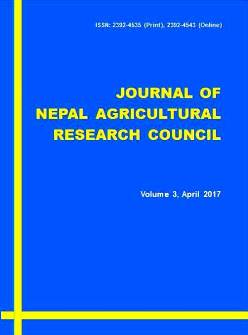Feeding Response of Tree Fodder Bhimal (Grewia optiva) on Growth Performance of Castrated Male Goats
DOI:
https://doi.org/10.3126/jnarc.v3i1.17268Keywords:
Goat, nutrition, fodder tree, Bhimal, NepalAbstract
Bhimal (Grewia optiva) is a fodder tree mostly found in mid hills of mid and far western region of Nepal. Bhimal could constitutes one of the main livestock green fodders, especially for goats when fresh green fodder become limited during the winter dry season. However, the feeding value of Bhimal leaves on growth performance of castrated goats probably has not been evaluated so far. Therefore, an experiment was conducted to evaluate the effect of Bhimal leaves feeding on growth performance of castrated male goats for 90 days. Altogether 16 growing castrated male goats of same breed, age and body weight were selected and equally divided into four treatments T1, T2, T3 and T4 with four replications by using Completely Randomized Design (CRD). Four types of experimental diets were prepared having various levels (0 to 100%) of Bhimal leaves as fodder. Experimental animals of Treatment 1 were fed with seasonal fodder + 100 g concentrate mixture, Treatment 2 with 100% Bhimal fodder + 100 g concentrate mixture, Treatment 3with 75% Bhimal fodder + 25% seasonal fodder + 100 g concentrate mixture, while Treatment 4 with 50% Bhimal fodder + 50% season fodder + 100 g concentrate mixture. All diets were fed ad-lib and experimental animals had free access to drinking water. The diets offered and refusal was measured daily and weight change was observed fortnightly. The result showed that fodder intake (g/d/animal) and total dry matter intake (TDMI g/kg live weight) of goats differed significantly (P<0.01), but concentrate intake was not differed significantly (P<0.01) among treatments. The highest dry matter intake per animal /day was in Treatment 2 (52.75 g/kg live weight) followed by Treatment 4, Treatment 3 and Treatment 1 (51.7, 48.56 and 32.69 g/kg live weight, respectively).The average daily gain in body weight was observed highest in Treatment 2 (66.66 g/d) followed by Treatment 3 (31.66 g/d) and Treatment 4 (30.83 g). The growth rate was significantly (P<0.01) different among diet groups (P<0.05, P<0.01 and P<0.01 for 60, 75 and 90 days, respectively). In case of the feed conversion ratio, Treatment 2 had best ratio (8.79:1) than Treatment 1 (14.21:1), T3 (17.03:1) and Treatment 4 (18.59:1). The present response study showed that body weight in castrated male goats can be increased significantly (P<0.05) implying that in winter season when other green forages are poorly available goat farming can be supported by Bhimal fodder tree.
Journal of Nepal Agricultural Research Council Vol.3 2017: 1-11




